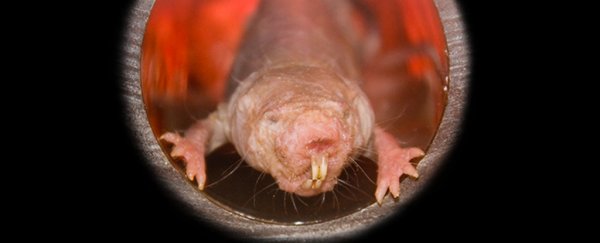Hearing loss in humans can make life challenging in our hustle-bustle landscape. But when your world is literally as silent as a grave, being hard of hearing just might be something of a superpower.
For naked mole rats and their cousins, the loss of genes that would usually amplify noises is another extraordinary adaptation in a long line of tricks they've evolved to withstand the stresses of a subterranean lifestyle.
Pale and bald with saggy skin, big teeth and rudimentary eyes, these thumb-sized East-African mammals aren't exactly blessed in the looks department. Not that it matters when you spend virtually your entire existence in darkness.
Being social animals, what does matter is an ability to communicate with other members of your clan in some way, so it shouldn't be all that surprising that mole rats like them tend to be chatty little critters.
What is surprising is that all of that talk falls on ears that might have trouble hearing much of it.
"Naked mole rats are constantly chirping and squeaking," says neuroscientist Thomas Park, from the University of Illinois Chicago.
"We were curious about their hearing since they are so vocal, but research had suggested that their hearing is actually quite bad."
Just how bad their hearing is – and why – is the question Park and his colleagues set out to answer.
Using similar technology to that used to test the hearing of human newborns, the researchers measured the response of auditory nerves to sound stimulation in two species of mole rat, the naked mole rat (Heterocephalus glaber) and a slightly more dapper cousin, the Damaraland mole rat (Fukomys damarensis).
As a point of comparison they also measured the hearing in mice in the same way.
Much as they expected, their hearing wasn't the best. In fact, it was so bad, if their subjects were humans they'd easily qualify for hearing aids.
Typical human hearing is anywhere from 20 hertz to 20 kilohertz, though for those of us hitting middle age anything above 14 kilohertz is a gift.
Subjected to tones ranging from 250 hertz to 6 kilohertz, the two naked mole rats they tested could only detect sounds between 500 hertz and 4 kilohertz. The four Damaraland mole rats they tested on came out even worse, topping out at 2 kilohertz.
For mice, the hearing went all the way up to 32 kilohertz. Though they also couldn't pick up the same, smooth bass tones as the mole rats, hearing nothing below 6 kilohertz.
Given so few mole rats were used in the study, it's possible they just happened to snatch up a couple of unlucky grandpas. But the hearing test was just for starters.
Confident that previous studies were on the money as far as their poor hearing goes, the team turned their attention to the genes behind the mole rat's hearing.
Again, previous research had suggested there was something going on. A look at the transcriptome – the library of genes expressing themselves in particular tissues – had already revealed genes related to hearing that evolution had seemed to favour.
With all of this in mind, the researchers dug even deeper, comparing the kinds of changes in half a dozen mole rat genes with mutations responsible for hearing impairment in humans.
The ultimate cause of the mole rat's reduced range of hearing can be traced to the absence of a functional cochlear amplifier, an otherwise common biological system among vertebrates.
This arrangement of microscopic hairs improves sensitivity to both frequency and volume. Two things mole rats, it seems, really have no need for.
In fact, not only do they have no need for better hearing, having it just might damage their sensitivity to the narrow range of frequencies they do have.
"Because the naked mole-rats lack functional cochlear amplification, the sounds they hear don't ever get up to a level where they are lethal to hair cells, and so the naked mole-rats can withstand this constant cacophony without going totally deaf," Park says.
"They are the only mammals we know of that lack cochlear amplification."
It's mostly speculation for now, but further research could help confirm the cause of their hearing loss.
Standing alone in its field is nothing all that new for this odd little underground rodent. Cancer isn't a word you'll find in their dictionary. They not only tolerate high levels of carbon dioxide and the irritating effects of its acidic touch, they rely on the gas for their health.
And who needs to shout commands when you can just force your family into looking after your babies through the mind-controlling pheromones leaking out of your faeces?
Further research into their unique senses might help us better understand how hearing loss occurs in humans, or even how we might go about repairing it.
It's just one more thing that makes the mole rat more than just a pretty face.
This research was published in Current Biology.
